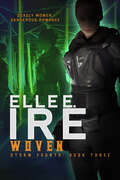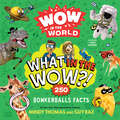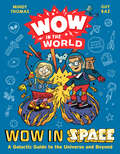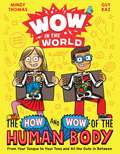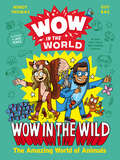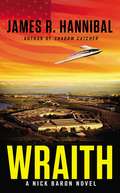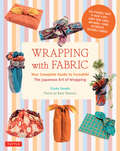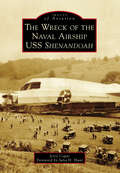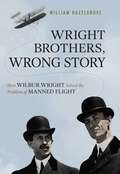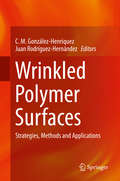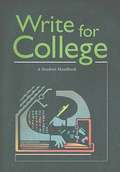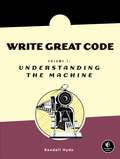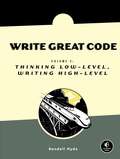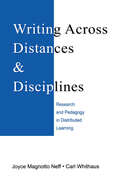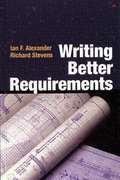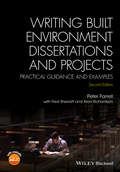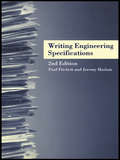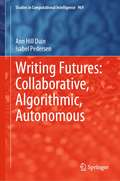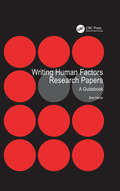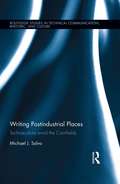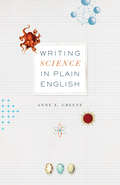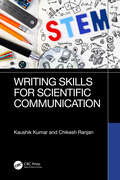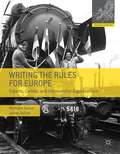- Table View
- List View
Woven (Storm Fronts #3)
by Elle E. IreStorm Fronts: Book ThreeWhat if the mirror does reflect what’s inside? Mercenary Vick Corren is steadfast in her love for empath Kelly LaSalle. When it comes to her love of herself, not so much. After an acidic-lake dunking on a distant moon shows Vick what’s really beneath her synthetic skin, it doesn’t matter that she heals. All she can see is the metallic shell of the soldier she once was. It’s a cruel reminder that she’s a cyborg. An AI. Less than human. And that's not Vick's biggest problem. Her clone, the sadistic VC2, is on the loose and on the hunt. Her mission? Eliminate Vick and make Kelly her own. Can Vick resolve her crippling identity crisis in time to defeat VC2—a terrifying version of herself that she might have been if not for Kelly’s love?
Wow in the World: 250 Bonkerballs Facts (Wow in the World)
by Mindy Thomas Guy RazFrom #1 New York Times bestselling authors Mindy Thomas and Guy Raz, hosts of the #1 kids podcast Wow in the World, comes a book bursting with 250 awe-inspiring, jaw-dropping science facts, photos, and illustrations.What in the wow is a “grumble” of pugs?Where in the wow can you sleep in a potato?Why in the wow is there poop on the moon?And how in the wow is a banana a berry?!From skunks who do handstands to a bridge made with eggs, the world is full of wowzerful stuff! Mindy Thomas and Guy Raz, hosts of the #1 children's podcast Wow in the World, are here with 250 of the most bonkerballs facts on Earth, covering topics such as animals, architecture, inventions, food, space, dinosaurs, and more!Filled with eye-popping photos and hilarious illustrations, this is a page-turning, jaw-dropping survey of some of the most astounding, gross, and all around weird scientific facts that will totally wow your world!
Wow in the World: A Galactic Guide to the Universe and Beyond (Wow in the World)
by Mindy Thomas Guy RazBased on their #1 podcast, Wow in the World, in this companion to the #1 New York Times bestseller The How and Wow of the Human Body, hosts Mindy Thomas and Guy Raz take readers on a funny and fact-filled tour of outer space.Calling all space cadets!Are you ready to explore the solar system, see the stars, and experience life in a world beyond ours?! Blast off with bestselling authors Mindy Thomas and Guy Raz, hosts of the mega-popular podcast Wow in the World, as they take you on an intergalactic tour of outer space.Zip through astronaut training school!Slip into a black hole!Apply for a job as a NASA astronaut!Learn what it takes to be a STAR!Get the recipe to build your own galaxy!Meet the animals who made it to space! And that’s just the beginning! Jam-packed with eye-popping illustrations, jaw-dropping facts, jokes, quizzes, comics, and everything else that makes up our universe, this is your one-stop shop for all things space. The who, what, when, where, why, how, and WOW—all in one place!
Wow in the World: From Your Tongue to Your Toes and All the Guts in Between (Wow in the World)
by Mindy Thomas Guy RazBased on their #1 kids podcast, Wow in the World, hosts Mindy Thomas and Guy Raz take readers on a hilarious, fact-filled, and highly illustrated journey through the human body—covering everything from our toes to our tongues to our brains and our lungs! <P><P>WHY in the world do I have a belly button? <P><P>And WHAT in the world does it do? <P><P>WHEN in the world will my nose stop growing? <P><P> And HOW in the world does my pee keep flowing? <P><P>The human body is a fascinating piece of machinery. It's full of mystery, and wonder, and WOW. And it turns out, every single human on the planet has one! Join Mindy Thomas and Guy Raz, hosts of the mega-popular Wow in the World podcast, as they take you on a fact-filled adventure from your toes and your tongues to your brain and your lungs. Featuring hilarious illustrations and filled with facts, jokes, photos, quizzes, and Wow-To experiments, The How and Wow of the Human Body has everything you need to better understand your own walking, talking, barfing, breathing, pooping body of WOW! <P><P><b>A New York Times Bestseller</b>
Wow in the World: The Amazing World of Animals (Wow in the World)
by Mindy Thomas Guy RazBased on their #1 kids podcast, Wow in the World, hosts Mindy Thomas and Guy Raz take readers on a hilarious, fact-filled, and highly illustrated journey through the animal kingdom!Feathers, fins, fur, feet—the animal kingdom is made up of nearly 9 million known species! From flying fish to flightless birds, each living creature has a unique role to play in the life of planet Earth. In this book, Mindy Thomas and Guy Raz, hosts of the mega-popular kids’ podcast Wow in the World, will take you on a fact-filled adventure to explore the funniest and most fascinating animals known to humankind.Sections include:Build your own insect!Play hide and seek, chameleon-style!Look for six signs you might be a fish!And much, much more!Featuring hilarious illustrations and filled with facts, jokes, photos, and quizzes, this book is a call to the wild kids of the world. Join us as we venture onto land and into the sky and sea to discover the WOW of Earth’s creatures, both big and small.
Wraith
by James R. HannibalAfter the towers fall on 9/11, Lieutenant Nick Baron and the rest of the 81st Fighter Squadron are desperate for action. But CENTCOM puts them on the sidelines, leaving the young Warthog pilots restless--and reckless. Then the unthinkable happens. During a high-risk training flight, a rookie wingman slams into the ground. In the darkness that follows, Nick wonders if he will ever learn to trust a wingman again--or even learn to trust himself. He will soon find out. Despite the black mark on his record, Nick's application to the elite Stealth Wing is approved. A recruiter for a new covert team has taken note of Nick's unique combination of skills. Suddenly Nick is swept into Operation Cerberus--a top secret mission that will take him from a harrowing flight over a black testing facility to a fight for his life on the Iraqi Dunes. "Hannibal brings together a terrific mix of real air technology with intrigue and nonstop action. A true suspenseful story that will keep you turning the pages until the exciting finale; it really is a great tale."--Clive Cussler "Get out of the way, Nelson DeMille. Brad Thor--you've got competition!"--Raymond Benson "A feast for thriller lovers!"--Grant Blackwood, New York Times bestselling author of The Kill Switch INCLUDES A PREVIEW OF SHADOW CATCHER James R. Hannibal (Lt Col, USAF Reserve), author of Shadow Maker and Shadow Catcher, is a graduate of the U.S. Air Force Academy who has flown the A-10 Warthog, the MQ-1 Predator drone, and the top secret B-2 Stealth Bomber, totaling over a thousand combat and combat support hours. He regularly reviews terrorism-related nonfiction for the New York Journal of Books.
Wrapping with Fabric
by Etsuko YamadaWrap anything from a wine bottle to a yoga mat with this practical Japanese fabric-wrapping book. Long before today's eco-friendly philosophy of "reduce, reuse, recycle" entered America's collective consciousness, furoshiki—the Japanese method of wrapping things with fabric—?ourished as a time-honored and practical art form. In Wrapping With Fabric, Etsuko Yamada—born into a long-line of furoshiki makers in Kyoto—explains the "one cloth, many uses" ideology behind the craft, the etiquette of color and the craft's fascinating history. From there, she shares the myriad ways in which a few basic techniques can transform a simple square of cloth into an elegant wrapper. Use your folded fabrics to: Gift-wrap anything from books to flowers Bundle up a picnic Tote items ranging from wine bottles to yoga mats Use as a handbag or backpack Make into a pillow covering Create decorative coverings for vases, tissue boxes, and more A quiet reminder that opportunities for artistry are everywhere around you, Wrapping With Fabric is the craft book that makes it easy to bring a touch of grace and ingenuity to everyday life—and help preserve the environment, too.
Wreck of the Naval Airship USS Shenandoah, The (Images of Aviation)
by Jerry Copas Julia H. HuntThe USS Shenandoah was the pride of the American Navy in 1925 and America�s first rigid dirigible. Her name is a Native American word often said to mean �Daughter of the Stars.� While performing a publicity tour in the Midwest, the ship was ripped to pieces by a violent storm. Fourteen men died, including Lt. Comdr. Zachary Landsowne, who remained at his post to the very end. The citizens of Noble County, Ohio, were alarmed and amazed when this high-tech, state-of-the-art marvel came tumbling out of the sky into their rural and isolated community. While lavishing care and support on the wounded, the locals also looted the wreckage and made souvenirs of valuable equipment that remained family treasures for years. Tales of daring heroism and sacrifice by those brave sailors on that stormy night soon became the thing of legend to the residents of the valley. For nearly 100 years, people there have maintained the legacy of Shenandoah with monuments, songs, and commemorations that continue to this day.
Wrestle the Mountain
by Phyllis Reynolds NaylorFrustrated by the narrowness of his West Virginia mining town, a boy with a talent for woodcarving yearns for a different way of life.
Wright Brothers, Wrong Story: How Wilbur Wright Solved the Problem of Manned Flight
by William Elliott HazelgroveThis book is the first deconstruction of the Wright brothers myth. They were not -- as we have all come to believe--two halves of the same apple. Each had a distinctive role in creating the first "flying machine." How could two misanthropic brothers who never left home, were high-school dropouts, and made a living as bicycle mechanics have figured out the secret of manned flight? This new history of the Wright brothers' monumental accomplishment focuses on their early years of trial and error at Kitty Hawk (1900-1903) and Orville Wright's epic fight with the Smithsonian Institute and Glenn Curtis. William Hazelgrove makes a convincing case that it was Wilbur Wright who designed the first successful airplane, not Orville. He shows that, while Orville's role was important, he generally followed his brother's lead and assisted with the mechanical details to make Wilbur's vision a reality. Combing through original archives and family letters, Hazelgrove reveals the differences in the brothers' personalities and abilities. He examines how the Wright brothers myth was born when Wilbur Wright died early and left his brother to write their history with personal friend John Kelly. The author notes the peculiar inwardness of their family life, business and family problems, bouts of depression, serious illnesses, and yet, rising above it all, was Wilbur's obsessive zeal to test out his flying ideas. When he found Kitty Hawk, this desolate location on North Carolina's Outer Banks became his laboratory. By carefully studying bird flight and the Rubik's Cube of control, Wilbur cracked the secret of aerodynamics and achieved liftoff on December 17, 1903. Hazelgrove's richly researched and well-told tale of the Wright brothers' landmark achievement, illustrated with rare historical photos, captures the excitement of the times at the start of the "American century."
Wrinkled Polymer Surfaces: Strategies, Methods and Applications
by Juan Rodríguez-Hernández C. M. González-HenríquezThis book presents the state of the art in surface wrinkling, including current and future potential applications in biomedicine, tissue engineering, drug delivery, microfluidic devices, and other promising areas. Their use as templates, flexible electronics, and supports with controlled wettability and/or adhesion for biorelated applications demonstrate how the unique characteristics of wrinkled interfaces play a distinguishing and remarkable role. The fabrication approaches employed to induce wrinkle formation and the potential to fine-tune the amplitude and period of the wrinkles, their functionality, and their final morphology are thoroughly described. An overview of the main applications in which these buckled interfaces have already been employed or may have an impact in the near future is included. Presents a detailed description of the physical phenomena and strategies occurring at polymer surfaces to produce wrinkled surface patterns;Examines the different methodologies to produce morphology-controlled wrinkled surface patterns by means of physical and chemical treatment methods;Provides clear information on current and potential applications in flexible electronics and biomaterials, which are leading the use of these materials.
Write For College: A Student Handbook
by Dave Kemper Patrick Sebranek Verne MeyerWrite for College emphasizes the kinds of writing that will prepare you for college course work. However, the handbook covers much more than writing. It also provides information and guidelines for speaking, thinking, critical reading, note taking, test taking, researching, and nearly every other topic essential to success.
Write Great Code, Volume 1: Understanding the Machine
by Randall HydeToday's programmers are often narrowly trained because the industry moves too fast. That's where Write Great Code, Volume 1: Understanding the Machine comes in. This, the first of four volumes by author Randall Hyde, teaches important concepts of machine organization in a language-independent fashion, giving programmers what they need to know to write great code in any language, without the usual overhead of learning assembly language to master this topic. A solid foundation in software engineering, The Write Great Code series will help programmers make wiser choices with respect to programming statements and data types when writing software.
Write Great Code, Volume 2: Thinking Low-Level, Writing High-Level
by Randall HydeIt's a critical lesson that today's computer science students aren't always being taught: How to carefully choose their high-level language statements to produce efficient code. Write Great Code, Volume 2: Thinking Low-Level, Writing High-Level shows software engineers what too many college and university courses don't - how compilers translate high-level language statements and data structures into machine code. Armed with this knowledge, they will make informed choices concerning the use of those high-level structures and help the compiler produce far better machine code - all without having to give up the productivity and portability benefits of using a high-level language.
Writing Across Distances and Disciplines: Research and Pedagogy in Distributed Learning
by Joyce Magnotto Neff Carl WhithausWriting Across Distances and Disciplines addresses questions that cross borders between onsite, hybrid, and distributed learning environments, between higher education and the workplace, and between distance education and composition pedagogy. This groundbreaking volume raises critical issues, clarifies key terms, reviews history and theory, analyzes current research, reconsiders pedagogy, explores specific applications of WAC and WID in distributed environments, and considers what business and education might teach one another about writing and learning. Exploring the intersection of writing across the curriculum, composition studies, and distance learning , it provides an in-depth look at issues of importance to students, faculty, and administrators regarding the technological future of writing and learning in higher education.
Writing Better Requirements
by Richard Stevenson Ian F. AlexanderIf you are involved in the systems engineering process in any company, you will learn how to write requirements to get the system you want.
Writing Built Environment Dissertations and Projects: Practical Guidance and Examples
by Alan Richardson Fred Sherratt Peter FarrellWriting Built Environment Dissertations and Projects will help you to write a good dissertation or project by giving you a good understanding of what should be included, and showing you how to use data collection and analysis tools in the course of your research. Addresses prominent weaknesses in under-graduate dissertations including weak data collection; superficial analysis and poor reliability and validity Includes many more in-depth examples making it easy to understand and assimilate the concepts presented Issues around study skills and ethics are embedded throughout the book and the many examples encourage you to consider the concepts of reliability and validity Second edition includes a new chapter on laboratory based research projects Supporting website with sample statistical calculations and additional examples from a wider range of built environment subjects
Writing Engineering Specifications
by Paul Fitchett Jeremy HaslamEngineers need to understand the legal and commercial context in which they draw up technical specifications. This thoroughly up-dated edition of Haslam's successful Writing Engineering Specifications provides a concise guide to technical specifications and leads the reader through the process of writing these instructions, with clear advice to help the student and professional avoid legal disputes or the confusion and time wasting caused by poor drafting. Designers and project managers should find this invaluable, and it should be helpful to insurers, lawyers, estimators and the like.
Writing Futures: Collaborative, Algorithmic, Autonomous (Studies in Computational Intelligence #969)
by Ann Hill Duin Isabel PedersenThis book is useful to understand and write alongside non-human agents, examine the impact of algorithms and AI on writing, and accommodate relationships with autonomous agents. This ground-breaking future-driven framework prepares scholars and practitioners to investigate and plan for the social, digital literacy, and civic implications arising from emerging technologies. This book prepares researchers, students, practitioners, and citizens to work with AI writers, virtual humans, and social robots. This book explores prompts to envision how fields and professions will change. The book’s unique integration with Fabric of Digital Life, a database and structured content repository for conducting social and cultural analysis of emerging technologies, provides concrete examples throughout. Readers gain imperative direction for collaborative, algorithmic, and autonomous writing futures.
Writing Human Factors Research Papers: A Guidebook
by Don HarrisWriting high-quality papers suitable for publication within international scientific journals is now an essential skill for all early-career researchers; their career progression and the reputation of the department in which they work depends upon it. However, many manuscripts are rejected or sent back for major re-working not because the science they contain is in any way 'bad', but because the same problems keep occurring in the way that the material is presented. It is one thing to write a good scientific paper, however it is quite another thing to get it published. This requires some additional nous. In writing this book Don Harris draws upon nearly a quarter of a century of experience as an author and reviewer of research papers, and ultimately as a journal editor. By his own admission, it contains all the things he wished that his mentors had told him 25 years ago, but didn't. The material in the book is drawn from many years of finding all these things out for himself, usually by trial and error (but mostly error!). The text adopts a much lighter touch than is normally found in books of this type - after all, who really wants to read a book about writing research papers? The author describes his own unique approach to writing journal papers (which, in his own words, has proved to be extremely successful). All major points are illustrated with examples from his own, published works. The book is written in the form of a manual for constructing a journal manuscript: read a chapter, write a section. However, the material it contains goes beyond just this and also describes how to select a target journal, the manuscript submission process, what referees are looking for in a good journal paper, and how to deal with the referees' comments. Each chapter concludes with a checklist to ensure all the key elements have been addressed.
Writing Postindustrial Places: Technoculture amid the Cornfields (Routledge Studies in Technical Communication, Rhetoric, and Culture)
by Michael J. SalvoExploring the relationship between postindustrial writing and developments in energy production, manufacturing, and agriculture, Michael J. Salvo shows how technological and industrial innovation relies on communicative and organizational suppleness. Through representative case studies, Salvo demonstrates the ways in which technical communicators formulate opportunities that link resources with need. His book is a supple articulation of the opportunities and pitfalls that come with great change.
Writing Science in Plain English
by Anne E. GreeneScientific writing is often dry, wordy, and difficult to understand. But, as Anne E. Greene shows in Writing Science in Plain English,writers from all scientific disciplines can learn to produce clear, concise prose by mastering just a few simple principles. This short, focused guide presents a dozen such principles based on what readers need in order to understand complex information, including concrete subjects, strong verbs, consistent terms, and organized paragraphs. The author, a biologist and an experienced teacher of scientific writing, illustrates each principle with real-life examples of both good and bad writing and shows how to revise bad writing to make it clearer and more concise. She ends each chapter with practice exercises so that readers can come away with new writing skills after just one sitting. Writing Science in Plain English can help writers at all levels of their academic and professional careers--undergraduate students working on research reports, established scientists writing articles and grant proposals, or agency employees working to follow the Plain Writing Act. This essential resource is the perfect companion for all who seek to write science effectively.
Writing Science: How To Write Papers That Get Cited And Proposals That Get Funded
by Joshua SchimelAs a scientist, you are a professional writer: your career is built on successful proposals and papers. Success isn't defined by getting papers into print, but by getting them into the reader's consciousness. Writing Science is built upon the idea that successful science writing tells a story. It uses that insight to discuss how to write more effectively. Integrating lessons from other genres of writing with those from the author's years of experience as author, reviewer, and editor, the book shows scientists and students how to present their research in a way that is clear and that will maximize reader comprehension. The book takes an integrated approach, using the principles of story structure to discuss every aspect of successful science writing, from the overall structure of a paper or proposal to individual sections, paragraphs, sentences, and words. It begins by building core arguments, analyzing why some stories are engaging and memorable while others are quickly forgotten, and proceeds to the elements of story structure, showing how the structures scientists and researchers use in papers and proposals fit into classical models. The book targets the internal structure of a paper, explaining how to write clear and professional sections, paragraphs, and sentences in a way that is clear and compelling. The ideas within a paper should flow seamlessly, drawing readers along. The final section of the book deals with special challenges, such as how to discuss research limitations and how to write for the public.
Writing Skills for Scientific Communication
by Kaushik Kumar Chikesh RanjanWriting Skills for Scientific Communication is a comprehensive guide designed for researchers, students, and professionals striving for excellence in academic and innovative endeavours. Covering every stage of the research journey, it provides insights into defining research problems, conducting literature reviews, and crafting impactful research papers. The book explores intellectual property rights, the patenting process, and licensing, offering practical strategies for protecting and commercializing innovations. Enriched with real-world case studies, ethical guidelines, and technical writing techniques, this guide offers a holistic approach to mastering research and IP management.This book: Offers a complete and systematic guide to scientific writing, covering various aspects, such as clarity, structure, organization, and language usage, to help readers effectively communicate their research Presents in-depth coverage of how to write research articles, including insights into different sections like the abstract, introduction, methods, results, discussion, and conclusion Illustrates extensive information on how to create and use graphs, tables, and figures to present research data effectively, and enhance the understanding of readers Showcases guidance on tailoring scientific communication for different audiences, including experts in the field, peers, and policymakers Discusses ethical aspects of scientific communication, including plagiarism, data manipulation, and responsible authorship Whether you're a novice or an experienced researcher, this book equips you with the essential tools to thrive in the dynamic landscape of scientific communication. It is written for senior undergraduates and graduate students in diverse fields including mechanical engineering, industrial and manufacturing engineering, electrical engineering, electrical and electronics engineering, and computer engineering.
Writing The Rules For Europe: A Practical Guide To The Future
by Wolfram Kaiser Johan SchotTechnologies have created crucial connections across borders requiring new forms of regulation. This book analyzes how experts, cartels and international organizations have written the rules for Europe since around 1850. Based on fresh research in the archives of multiple international organizations and European countries it explores the "hidden integration" of Europe forms of integration that were not always visible, but affected the citizens of Europe in their everyday lives. Richly illustrated and engagingly written, the book de-centers the present-day European Union in a new long-term understanding of European integration. "
